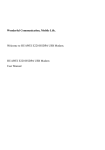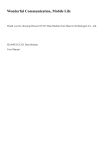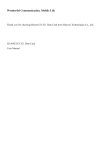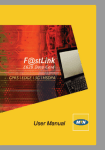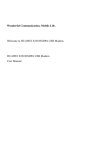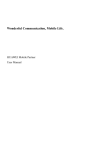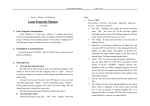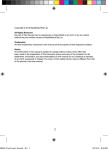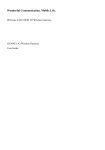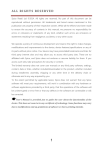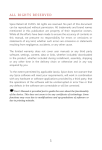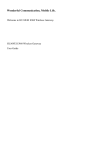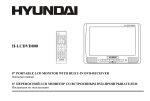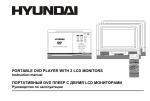Download Wonderful Communication, Mobile Life.
Transcript
Wonderful Communication, Mobile Life. Welcome to HUAWEI E220 HSDPA USB Modem. HUAWEI E220 HSDPA USB Modem User Manual Copyright © 2006 Huawei Technologies Co., Ltd. All Rights Reserved No part of this manual may be reproduced or transmitted in any form or by any means without prior written consent of Huawei Technologies Co., Ltd. Trademarks and HUAWEI are trademarks of Huawei Technologies Co., Ltd. All other trademarks mentioned in this manual are the property of their respective holders. Notice The information in this manual is subject to change without notice. Every effort has been made in the preparation of this manual to ensure accuracy of the contents, but all statements, information, and recommendations in this manual do not constitute the warranty of any kind, expressed or implied. Table of Contents 1 Getting Started....................................................................................................1 Getting to Know Your E220 .........................................................................1 Indicator .......................................................................................................1 Computer Configuration Requirements........................................................2 Preparing E220.............................................................................................2 2 Installation..........................................................................................................4 Connecting E220 to the PC ..........................................................................4 Installing the E220 Mobile Connect Management Program.........................6 Disconnecting E220 from the PC .................................................................6 Uninstalling Mobile Connect .......................................................................7 3 Introduction to Mobile Connect..........................................................................8 Launching Mobile Connect ..........................................................................8 Introduction to the Home Screen..................................................................8 4 Internet Service ................................................................................................11 Network Connection Settings.....................................................................11 Accessing the Internet ................................................................................12 Volume Statistic..........................................................................................13 5 SMS..................................................................................................................14 Sending or Receiving a Message................................................................14 Message Import Management ....................................................................23 SMS Settings..............................................................................................23 i 6 Contacts............................................................................................................25 Managing Contacts.....................................................................................25 Importing/Exporting Contacts....................................................................27 7 Settings and Information Query........................................................................29 Selecting the Network ................................................................................29 Selecting the Connection Type ...................................................................29 Selecting the Band......................................................................................29 Managing the PIN Code.............................................................................30 System Settings ..........................................................................................31 Diagnostic ..................................................................................................32 8 Specifications ...................................................................................................34 9 FAQ ..................................................................................................................36 10 Warnings and Precautions...............................................................................38 Electronic Device .......................................................................................38 Hospital ......................................................................................................38 Area with flammables and Explosives .......................................................38 Traffic Safety..............................................................................................39 Storage Environment..................................................................................39 Children Safety ..........................................................................................39 Operating Environment ..............................................................................40 Cleaning and Maintenance .........................................................................40 Environmental Care ...................................................................................41 Certification Information (SAR) ................................................................41 FCC Statement ...........................................................................................42 11 Acronyms and Abbreviations..........................................................................43 ii 1 Getting Started Getting to Know Your E220 Welcome to HUAWEI E220 HSDPA USB Modem (hereinafter referred to as E220). With E220, you can easily: Access the Internet Send or receive text messages y Manage contacts The following figure shows E220. y y USB interface Indicator USIM/SIM card slot Note: The figure is for your reference only. Indicator This indicator indicates the status of E220. 1 Indicator Status Description Off E220 is powered off. Blinking twice every 2.7 seconds (green) E220 is searching for a network or no network is available. Blinking once every 2.9 seconds (green) The GSM network is normal. Blinking once every 2.9 seconds (blue) The WCDMA network is normal. On (green) The GPRS data service is established. On (cyan) The HSDPA data service is established. On (blue) The WCDMA data service is established. Computer Configuration Requirements To use E220, your PC is required to have: y y y y y y CPU: Pentium 4, 1 GHz or above Memory: 128 MB RAM or above Hard disk: 50 MB or above Operating system: Windows XP or Windows 2000 USB modem interface: USB 2.0 full speed Display resolution: 800 % 600 or above; 1024 % 768 is recommended Note: Make sure that the configuration of your PC meets the requirements. Otherwise, improper configuration may degrade the performance of your PC. Preparing E220 1 Take out E220 from the protective cover. 2 2 Take out the USIM/SIM card slot from E220. Then insert the USIM/SIM card into the USIM/SIM card slot. Make sure that the USIM/SIM card is fully inserted. 3 Insert the USIM/SIM card slot into E220. 3 2 Installation The installation procedures vary with the operating system. The following installation procedures are for your reference only. Take the Windows XP operating system as an example. Note: y y y For Windows XP, it is recommended to install patches such as Service Pack 2 or above. For Windows 2000, it is recommended to install patches such as Service Pack 4 or above. Before connecting E220 to the PC, power on the PC. Otherwise, the installation may be affected. Connecting E220 to the PC Use the dedicated USB cable to connect E220 to the PC. The following figure shows the USB cable. Auxiliary USB data cable Main USB data cable Do the following to connect E220 to the PC: 4 Mini-USB connector 1 Connect the Mini-USB plug of the USB cable to the USB interface of E220. 2 Insert the main plug and auxiliary plug to the USB interfaces of the PC. Note: The PC can supply power for E220 through the auxiliary USB data cable. Make sure that it is connected to the USB interface of the PC. on the 3 Windows XP auto detects and recognizes E220 and displays lower right corner, indicating that E220 is connected successfully. 5 Installing the E220 Mobile Connect Management Program 1 Connect E220 to the PC. 2 The setup program auto runs. Then the E220 installation interface appears. Note: If the auto-run program does not start, double-click the AutoRun.exe file in the drive path to run it. 3 Select the language in the Choose Language dialog box and click Next. 4 Follow the remaining instructions. 5 Click Finish to complete the installation. Note: Do not disconnect E220 during the installation. of the Mobile 6 When the installation completes, the shortcut icon Connect management program (hereinafter referred to as Mobile Connect) appears on the desktop. Disconnecting E220 from the PC Before disconnecting E220, stop it through the hardware removing function of Windows. Do the following: 1 Double-click on the lower right corner of the PC screen and the Safely Remove Hardware dialog box is displayed. 2 Select Huawei Mass Storage USB Device to stop E220. 3 After the system prompts you that it is safe to remove the device, disconnect E220. 6 Uninstalling Mobile Connect Uninstall Mobile Connect through the Add or Remove Programs function of Windows. 7 3 Introduction to Mobile Connect Launching Mobile Connect 1 Connect E220 to the computer and Mobile Connect is auto launched. 2 If you are required to enter the Personal Identification Number (PIN) code, enter the correct one and click OK. If you enter wrong PIN codes three times consecutively, your USIM/SIM card is blocked. In this case, use the PIN Unblocking Key (PUK) code to unblock it. If you enter wrong PUK codes ten times consecutively, your USIM/SIM card is disabled. In this case, contact your service provider. Note: The service provider provides the PIN code and the PUK code. For details about how to modify, enable or disable the PIN code, refer to "Managing the PIN Code". Introduction to the Home Screen Overview of the Home Screen After Mobile Connect is launched, the home screen is displayed as follows: 8 You can maximize the screen. Icons and Shortcut Keys The following table lists the icons and corresponding shortcut keys of Mobile Connect. Icon/Shortcut Key / /F3 /F2 Description Connect to/Disconnect from the network. Launch the IE. Display the SMS interface. /F5 Display the Contacts interface. /F6 9 Status Information The status information shown on the right panel varies with the ongoing service. The following two tables list the status information and description. When the screen is in the minimized status: Status Information Description Signal The network type and signal strength. The more the bars are, the stronger the signal strength is. Network Service provider information. Duration The duration of the current data connection. Volume The volume of the current data connection. When the screen is in the maximized status: Status Information Description Signal The network type and the signal strength. Network Service provider information. Connection The current connection information: y Duration y Volume y Sent volume, rate, and the top rate y Received volume, rate, and the top rate The number of new messages. If there is a new message, the number blinks. Sent Received New messages New SMS reports 10 The number of new message reports. If there is a new message report, the number blinks. 4 Internet Service Network Connection Settings Creating a Profile Select Settings > Network Connection Settings…. Then do the following: Step Procedure 1 Click New. 2 Enter the profile name. 3 Enter the APN, IP, authentification, DNS, WINS, and authentication protocol. 4 Click Save. Note: For details of network connection settings, consult your service provider. Deleting a Profile Select Settings > Network Connection Settings…. Then, do the following: Step Procedure 1 In the Choose Profile Name field, select the profile. 2 Click Remove > OK. 11 Modifying a Profile Select Settings > Network Connection Settings…. Then, do the following: Step 1 Procedure In the Choose Profile Name field, select the profile. 2 Click Modify. 3 Modify the profile. 4 Click Save. Accessing the Internet You can access the Internet through a 3G or GPRS connection. Select Settings > Network Connection Settings…. Then do the following: Step 1 2 3 Procedure In the Choose Profile Name field, select the profile and click OK. Click to establish the 3G connection or the GPRS connection. After a prompt is displayed indicating that the connection is established, click or launch the browser of the operating system. Then you can access the Internet. 4 Click to disconnect the connection. When the connection is established, details of the network connection are displayed as follows: y y y The current connection duration The data volume of the current connection The volume, rate and the top rate of the sent and received data 12 Volume Statistic You can view the details of the volume statistic. Select Tools > Volume Statistic… to view: y y y y Last Volume Statistic: the volume of the last connection, including the sent volume, the received volume, and the duration Total Volume Statistic: the volume of all connections, including the sent volume, the received volume, and the duration Last Reset Time: the last reset time Reset: Click it to reset Note: y y The volume statistic is for your reference only. If you do not perform the reset operation, the last reset time is null. 13 5 SMS Sending or Receiving a Message Creating a Message Click Step or select Tools > SMS, the SMS interface is displayed. Procedure 1 Click Write and the Write interface is displayed. 2 Enter the phone number by one of the following ways: y Enter the phone number: In the Contacts field, enter the phone number and use the semicolon to separate phone numbers. y Select the contact: Click Contacts. Select one or more contacts and click OK. In the pop-up dialog box, select the phone numbers and click OK. Note: y You can enter a phone number or select a contact. y To select several contacts, press and hold the Shift key or the Ctrl key. y To select several contacts, select the Apply to all items check box to simplify the procedures. Write the message. Note: On the upper right corner of the interface, the number of remaining characters and the number of the message is split are displayed. 3 14 Step 4 y y y Procedure Click Send to send the message. After the message is sent, it is auto saved to the Outbox. If the sending fails, a prompt is displayed asking whether to send it again. If you cancel the sending, the message is auto saved to the Outbox. Click Save to save the message to the Draft. Click Clear to clear the phone number and the message. Note: y y y Mobile Connect supports the group sending function. You can send a message to up to 20 phone numbers. Each message can contain 70 Chinese characters or 160 English letters. If a message contains more than 70 Chinese characters or 160 English letters, it is split into several messages and sent one by one. You can follow the above-mentioned two ways to enter the phone number as the message recipient. Inbox The Inbox stores received messages. It can store up to 1,000 messages. If the Inbox is full and there is a new message, the oldest message is auto moved to the Trash. If there is an unread message, the number is displayed on the right panel of the home screen. On the SMS interface, click Inbox to access the Inbox. Viewing a Message You can view a message in the Inbox. Step 1 2 Procedure Click or select Tools > SMS. The SMS interface is displayed. Click Inbox to access the Inbox. Double-click the message to view details. 15 There are two types of icons in the Inbox: : Unread messages y : Read messages You can view a message upon its arrival. y If there is a new message, you can hear an alert tone or view an alert window. For details, refer to "System Settings". 1 With the alert tone function enabled: If there is a new message, you can hear the alert tone. Step Procedure 1 Click 2 Click Inbox to access the Inbox. Double-click the message to view details. or select Tools > SMS. The SMS interface is displayed. 2 With the alert window function enabled: If there is a new message, you can see the alert window. Click To… View View details of the message. Close Close the alert window. Replying to a Message You can reply to a message in the Inbox. Step Procedure 1 Select or double-click the message to view details. Then click Reply. 2 The phone number of the sender is displayed in the Contacts field. You can edit the phone number. 3 Write the message. 4 Click Send. 16 Forwarding a Message You can forward a received message. Step Procedure 1 Select or double-click the message to view details. Then click Forward. 2 Enter the phone number of the recipient, or click Contacts to select the contact. 3 Details of the message are displayed in the text box. You can edit it. 4 Click Send. Deleting a Message You can delete a received message. Step 1 2 Procedure Select one or more messages. y Double-click the message to view details. Click Delete. The message is moved to the Trash. y Saving a Phone Number You can save the phone number of a received message as a contact. Step Procedure 1 Select or double-click the message to view details and click Get Number. 2 The New interface is displayed and the phone number of the message is displayed in the Mobile Number field. 3 Enter the information of the phone number. 4 Click Save. 17 Exporting a Message You can export received messages to a file. The file must be .txt or .csv files. Step Operation 1 Select one or more messages. 2 Right-click the window and select Export to file. 3 Select the path and enter the file name. 4 Click Save. Locking/Unlocking a Message To avoid unintentional deletion, you can lock a message in the Inbox. In addition, you can unlock a message. Step Operation 1 Select one or more messages. 2 Right-click the window and select Lock or Unlock. Note: A locked message is marked by . Outbox The Outbox stores sent messages. The Outbox can store up to 1,000 messages. If the Outbox is full and there is a new message, the oldest message is auto moved to the Trash. On the SMS interface, click Outbox to access the Outbox. Viewing a Message You can view a message in the Outbox. Step Procedure 1 You can view all the messages in the Outbox. 2 Double-click the message to view details. 18 Sending a Message In the Outbox, you can send a message. Step 1 2 Procedure Select or double-click the message to view details. Then click Send. y You can send a message to several recipients each time. Select several messages and click Send. The phone number of the recipient is displayed in the Contacts field. You can edit the phone number. y 3 Write the message. 4 Click Send. Forwarding a Message In the Outbox, you can forward a sent message. Step Procedure 1 Select or double-click the message to view details. Then click Forward. 2 Enter the phone number of the recipient in the Contacts field, or click Contacts to select the contact. 3 Details of the message are displayed. You can edit the message. 4 Click Send. Deleting a Message You can delete a message. Step 1 2 Procedure Select one or more messages and click Delete. y Double-click the message to view details and click Delete. The message is moved to the Trash. y 19 Saving a Phone Number You can save the phone number of a sent message as a contact. Step Procedure 1 Select or double-click the message to view details and click Get Number. 2 The New interface is displayed and the phone number of the message is displayed in the Mobile Number field. 3 Enter the information of the phone number. 4 Click Save. Exporting a Message You can export sent messages to a file. The file must be .txt or .csv files. Step Operation 1 Select one or more messages. 2 Right-click the window and select Export to file. 3 Select the path and enter the file name. 4 Click Save. Locking/Unlocking a Message To avoid unintentional deletion, you can lock a message in the Outbox. In addition, you can unlock a message. Step Procedure 1 Select one or more messages. 2 Right-click the window and select Lock or Unlock. Note: A locked message is marked by 20 . Draft You can save a message as a draft. The Draft can store up to 1,000 messages. If you save a message as a draft, only the content of the message is saved. On the SMS interface, click Draft. Editing a Message You can edit a draft. Step 1 2 Procedure Select the draft and click Edit. y Double-click the draft. On the Write interface, edit the draft and click Send, Save, or Clear. y Deleting a Message You can delete a draft. Step Procedure 1 Select one or more drafts and click Delete. 2 The draft is moved to the Trash. 3 Click Save. Trash The Trash stores messages removed from the Inbox, Outbox, and Draft. The Trash can store up to 1,000 messages. If the Trash is full and there is a new message, the oldest message is auto deleted. On the SMS interface, click Trash. Restoring a Message You can restore a message. 21 Step Procedure 1 Select one or more messages and click Restore. 2 The message is restored. Deleting a Message If you delete a message from the Trash, it is permanently deleted. Step Procedure 1 Select one or more messages and click Delete. 2 Click OK. Exporting a Message You can export messages to a file. The file must be .txt and .csv files. Step Procedure 1 Select one or more messages. 2 Right-click the window and select Export to file. 3 Select the path and enter the file name. 4 Click Save. Reports The Reports can store up to 1,000 delivery reports. If the Reports is full and there is a new report, the oldest report is auto deleted. On the SMS interface, click Reports. Step Procedure 1 Select one or more reports and click Delete. 2 Click OK. 22 Exporting a Report You can export reports to a file. The file must be .txt or .csv files. Step Procedure 1 Select one or more reports. 2 Right-click the window and select Export to file. 3 Select the path and enter the file name. 4 Click Save. Message Import Management You can import messages to Mobile Connect from the USIM/SIM card. Step Procedure 1 Select File > Import Message from USIM/SIM Card…. 2 Messages are imported to the Inbox, Outbox, or Draft of Mobile Connect respectively. SMS Settings Select Settings > SMS Settings and the SMS Settings interface is displayed. Option Description Reports You can enable or disable this function. With the function enabled, if you send a message successfully, you can receive a delivery report. Use same SMS centre for reply Set the recipient to use the same SMS center number to reply the message. 23 Option SMS Bearer Domain Validity SMC Number Description Set the bearer domain of sending a message. y Circuit Switched (CS): messages are sent through the CS domain. y Packet Switched (PS): messages are sent through the PS domain. Set the validity period for a message saved in the SMS center. The SMS center number is supplied with the USIM/SIM card. After you insert the USIM/SIM card, the field is auto filled. If the field is null or you delete the number unconsciously, contact your service provider to retrieve the number. Note: If there is no capacity for delivery reports in the USIM/SIM card, the request status report function is invalid, contact your service provider for details. 24 6 Contacts Mobile Connect can save up to 1,000 contacts. You can create, modify, or delete contacts. You can send a message or make a call to the contact. You can also import or export contacts. Managing Contacts Click or select Tools > Contacts. The Contacts interface is displayed. Creating a Contact Do the following: Step Procedure 1 Click New. 2 Enter the content in the Name, Mobile Number, Home Number, Office Number, E-mail, and/or Comments fields. 3 Click Save. Modifying a Contact Do the following: Step Procedure 1 Select or double-click the contact and click Edit. 2 Modify the contact. 3 Click Save. 25 Deleting a Contact Do the following: Step Procedure 1 Select one or more contacts. Then click Delete. 2 Click OK. Sending a Message You can send a message to a contact. Do the following: Step Procedure 1 Select one or more contacts. 2 Click Send. Mobile Connect retrieves the phone number and the Write interface is displayed. 3 The phone number is displayed in the Contacts field. Write the message and click Send. Searching for a Contact You can search for a contact. Do the following: Step 1 Procedure 3 Click Search. Select a field item such as Name, Mobile, Family, Office or E-mail from the dropdown list in the Condition area. y Enter the content in the Value text box. y Select Match Whole Word Only and/or Match Case in the Matching Type field. Click Search Now to start searching. 4 Click Stop Search to stop searching. 2 26 y Importing/Exporting Contacts Importing a Contact You can import contacts to Mobile Connect from the USIM/SIM card or a file. Importing a Contact from a File You can import contacts to Mobile Connect from a file. The file must be .csv files. Step Procedure 1 Select File > Import Contacts > From File. 2 In the Open dialog box, select the file. 3 Click Open to import the file to Mobile Connect. Importing a Contact from the USIM/SIM Card You can import contacts to Mobile Connect from the USIM/SIM card. Step Procedure 1 Select File > Import Contacts > From USIM/SIM Card. 2 You can select: Move Import: Contacts in the USIM/SIM card are deleted. y Copy Import: Contacts in the USIM/SIM card are retained. Click OK. Then select Mobile Telephone Number, Family Telephone Number or Office Telephone Number and set whether to apply the operations to all items. Then click OK. y 3 4 After the importing completes, a prompt is displayed to indicate the result. Exporting a Contact You can export contacts from Mobile Connect to the USIM/SIM card or a file. 27 Exporting a Contact to a File Do the following: Step Procedure 1 Select File > Export Contacts > To File. Then click OK in the pop-up dialog box. 2 In the Save as dialog box, enter the file name with .csv as its extension. 3 Click Save. Exporting a Contact to the USIM/SIM Card Do the following: Step Procedure 1 Select one or more contacts. Note: If you do not select a contact, the function is unavailable. 2 Select File > Export Contacts > To USIM/SIM Card. 3 Click OK. 4 After the exporting completes, a prompt is displayed to indicate the result. Note: y y 28 The number of contacts that can be saved is determined by the capacity of the USIM/SIM card. If the contacts you are exporting exceed the USIM/SIM card capacity, Mobile Connect auto stops the operation. 7 Settings and Information Query Selecting the Network E220 supports manual or auto search of the network. To set the search mode, select Settings > Choose Network and select either of the following options: y y Auto: E220 auto searches for a network and registers to the network. Manual: You can manually search for networks and select a network for E220 to register. Selecting the Connection Type Select Settings > Choose Connection Type to set the connect type. Option Description 3G Preferred If possible, E220 selects the 3G network. GPRS Only E220 selects the GPRS network only. 3G Only E220 selects the 3G network only. Selecting the Band You can set the working band for E220. After setting, E220 can work only in the preset working band. Select Settings > Band Selection. Then you can select All Band, GSM900/1800/WCDMA2100 or GSM1900. 29 Managing the PIN Code The PIN code can protect the USIM/SIM card from unauthorized use. The PIN code is supplied with the USIM/SIM card. You can change your PIN code .Also you can set whether to enter the PIN code when E220 starts up. Modifying the PIN Code You can modify the PIN code. Do the following: Step Procedure 1 Select Settings > Modify PIN Code. 2 Enter the current PIN code and the new PIN code, and then enter the new code again to confirm it. 3 Click OK. Validating the PIN Code After launching Mobile Connect, you can still use the PIN code validation function. Do the following: Step Procedure 1 Select Settings > PIN Code Protection. 2 Select Validate to enable the PIN code validation function. For details, refer to the descriptions on page 8. PIN Code Protection You can enable or disable the PIN code when the E220 starts up. Step 1 30 Procedure Select Settings > PIN Code Protection. Step 2 Procedure Select Enable or Disable. Enter the PIN code. y Enable: You need to enter the PIN code when E220 starts up. y Disable: You do not need to enter the PIN code when E220 starts up. System Settings The system settings include the startup mode of Mobile Connect, the alert mode for messages, and the standby/hibernate mode of the PC and so on. Select Settings > Options. Setting Startup Click the Startup tab to set the following items. Option Description Launch application on Windows start up Mobile Connect is launched along with the Windows. Start main window minimized The Mobile Connect window is minimized on startup. Check the unread message(s) while starting On launching, Mobile Connect checks the unread messages in the USIM/SIM card and E220. Note: Click Default to restore the settings to the default values, namely, only the Check the unread message(s) while starting check box is selected. Setting SMS Alerts Function Select the SMS Alerts tab to set the following items. 31 Option Alert window Alert tone Description Select the Alert window check box. If there is a new message, the alert window is displayed. You can: y Click View to view details. y Click Close to close the alert window. After you select a sound file, if there is a new message, the sound file is played. y y Click Browse to select the sound file. Click Play to pre-listen to the sound file. Note: y y The SMS sound files must be *.wav or *.mid files. If you click Default, all the items in the prompts tab are restored to the default values. That is, both the Alert window check box and the Alert tone check box are selected. Setting the Standby/Hibernate Mode Click the Standby/Hibernate tab to set the following items. Option Description Prevent Standby/Hibernate Prevent the PC from turning to the standby or hibernate mode. Allow Standby/Hibernate Allow the computer to turn to the standby or hibernate mode. Note: If you click Default, the standby/hibernate status recovers to its default value, that is, allow standby or hibernate. Diagnostic You can inquire E220 and the USIM/SIM card. 32 Select Tools > Diagnostics: y y y y y y Messages in USIM/SIM Card: The format is "XX/YY". XX indicates the number of messages, and YY indicates the capacity of the USIM/SIM card. Contacts in USIM/SIM Card: The format is "XX/YY". XX indicates the number of contacts, and YY indicates the capacity of the USIM/SIM card. IMEI Number: the IMEI number of E220. API Version: the API version. Firmware Version: the board software version of E220. Hardware Version: the hardware version of E220. 33 8 Item Specifications Description Technical standard 3GPP R5 USB interface standard USB2.0 full speed standard Radio system GSM/GPRS/EDGE: 900 MHz/1800 MHz /1900 MHz y HSDPA /WCDMA: 2100 MHz GSM/GPRS/EDGE 900 MHz y UL: 880 MHz–915 MHz y DL: 925 MHz–960 MHz GSM/GPRS/EDGE 1800 MHz y UL: 1710 MHz–1785 MHz y DL: 1805 MHz–1880 MHz GSM/GPRS/EDGE 1900 MHz y UL: 1850 MHz–1910 MHz y DL: 1930 MHz–1990 MHz HSDPA/WCDMA 2100 MHz y UL: 1920 MHz–1980 MHz y DL: 2110 MHz–2170 MHz y HSDPA/WCDMA 2100 MHz: Power Class 3, +24 dBm+1/-3 y GSM/GPRS 900 MHz: Power Class 4, +33 dBm±2 y GSM/GPRS 1800 MHz: Power Class 1, +30 dBm±2 y GSM/GPRS 1900 MHz: Power Class 1, +30 dBm±2 y EDGE 900 MHz: Power Class E2, +27 dBm±3 y EDGE 1800 MHz: Power Class E2, +26 dBm±3 y EDGE 1900 MHz: Power Class E2, +26 dBm±3 Radio frequency band Radio power output 34 y Item Description Services Data service: y GSM CS: UL 9.6 kbit/s/DL 9.6 kbit/s y GPRS: UL 26.8 kbit/s/DL 53.6 kbit/s y EDGE: UL 118.4 kbit/s/DL 236.8 kbit/s y WCDMA CS: UL 64 kbit/s/DL 64 kbit/s y WCDMA PS: UL 384 kbit/s/DL 384 kbit/s y UL WCDMA/DL HSDPA: UL 384 kbit/s/DL 3.6 Mbit/s SMS service: GSM, GPRS, WCDMA, HSDPA, EDGE Dimensions (D % W % H) 89.37 mm % 42.61 mm % 14.50 mm Weight About 50 g Power supply method Through two USB interfaces Operating temperature -10℃ to +55℃ Storage temperature -40℃ to +70℃ 35 9 FAQ How to judge whether E220 is correctly connected to the PC? After you connect E220 to the PC, two device icons are displayed in the device manager, namely, “HUAWEI Mobile Connect-3G Modem” and “HUAWEI Mobile Conncet-3G PC UI Interface”. If a yellow exclamatory mark or other signs are displayed in front of the icons, it indicates that E220 is not correctly connected. You need to connect E220 again. What to do if E220 fails to connect to the Internet? 1 Make sure that E220 is in the service area and the network signal is normal. 2 Make sure you have subscribed to the wireless access service. For details, consult your service provider. 3 If you have subscribed to the wireless access service, refer to "Internet Service" to configure the network settings. Only part of the message is displayed after I use the “Paste” function to edit it. Why? A text message can contain up to 1,000 characters. If the size of the pasted part exceeds the limit, the exceeding part is auto deleted. When there is a new message, no alert window is displayed. Why? Make sure that you have enabled the alert window function. Select Settings > Options. Then select the SMS Alerts tab and check box in Message Alerts Settings. 36 After Mobile Connect is launched, the system prompts “There are some unread messages in USIM/SIM card. Do you want to import them to the computer?” After I select “No”, what if I want to import the message? Select File > Import Message from USIM/SIM Card to import messages to Mobile Connect from the USIM/SIM card. I cannot paste the phone number. Why? Only “0123456789#*+” is valid. Make sure that all digits of the phone number are valid. 37 10 Warnings and Precautions Electronic Device y y Switch off your wireless device near high-precision electronic devices. The wireless device may affect the performance of these devices. Such devices include hearing aids, pacemakers, fire alarm systems, automatic gates, and other automatic-control devices. If you are using an electronic medical device, consult the device manufacturer and confirm whether the radio wave affects the operation of this electronic device. Hospital Pay attention to the following points in hospitals or health care facilities: y y Do not take your wireless device into the operating room (OR), intensive care unit (ICU), or coronary care unit (CCU). Do not use your wireless device at places for medical treatment where it is prohibited to use wireless devices. Area with flammables and Explosives In the area with inflammables and explosives, disconnect your wireless device from your PC and turn off the PC to avoid explosion and fire. The area with inflammables and explosives include: y y y y y y Gas station Area for storing fuels (such as the bunk under the deck of a ship) Device/Vehicle for transporting and storing fuels or chemical products Area with chemical substances and particles (such as: granule, dust, metal powder) in the air Area with the sign of Explosives Area with the sign of Turn off bi-direction wireless equipment 38 y Area where it is generally suggested to stop the engine or a vehicle Traffic Safety y y y y Please observe the relevant regulation of the area or country where you are. Do not use your wireless device while driving to avoid traffic accident. Secure the wireless device on its holder. Do not place the wireless device on the seat or other places where it can get loose in a sudden stop or collision. Use the wireless device after the vehicle stops at a safety place. Do not place the wireless device over the air bag or in the air bag outspread area. Otherwise, the wireless device may hurt you owing to the strong force when the air bag inflates. Observe the rules and regulations of airline companies. On or nearby a plane, disconnect the wireless device from your PC and turn off the PC. In areas where it is prohibited to use wireless device, do not use the wireless device. Otherwise, the wireless signal of the wireless device can disturb the plane control signals. Disconnect the wireless device from your PC and turn off the PC before boarding an aircraft. Storage Environment y y y y Do not place magnetic storage media such as magnetic cards and floppy disks near the wireless device. Radiation from the wireless device may erase the information stored on them. Do not put your wireless device in containers with strong magnetic field, such as an induction cooker and a microwave oven. Otherwise, circuit failure, fire, or explosion can be caused. Do not leave your wireless device in a very hot or cold place. Otherwise, malfunction of the products, fire, or explosion can be caused. Do not put your wireless device in the pocket on the back side of trousers or a skirt to avoid wireless device damage while seating. Children Safety y Put your wireless device in places beyond the reach of children. Do not allow children to use the wireless device without guidance. 39 y Do not allow children to touch the small fittings. Otherwise, suffocation or gullet jam can be caused if children swallow the small fittings. Operating Environment y y y y y y y The wireless device is not water-resistant. Keep it dry. Protect the wireless device from water or vapor. Do not touch the wireless device with a wet hand. Otherwise, short-circuit and malfunction of the product or electric shock can be caused. Do not use the wireless device in dusty, damp and dirty places or places with magnetic field. Otherwise, malfunction of the circuit can be caused. When you carry or use the wireless device, keep it at least one inch (2.5 centimeters) away from your body, to avoid negative impact on your health caused by radio frequency leakage. On a thunder stormy day, do not use your wireless device outdoors. Do not touch the wireless device when it is running. This may affect call quality and cause the wireless device to operate with more power. The wireless device may interfere nearby TV sets and radios. In accordance with the international standards for radio frequency and radiation, use wireless device accessories approved by Huawei only. Cleaning and Maintenance y y y y Before you clean or maintain the wireless device, disconnect your wireless device from your PC and turn off the PC. Otherwise, electric shock or short-circuit may be caused. Do not use any chemical detergent, powder, or other chemical agent (such as alcohol and benzene) to clean the wireless device. Otherwise, part damage or a fire can be caused. You can clean the wireless device with a piece of soft antistatic cloth that is a little wet. Do not scratch the shell of the wireless device. Otherwise, the shed coating may cause skin allergy. Once it happens, stop using the wireless device at once and go to see a doctor. If the wireless device or any of its fittings does not work, turn to the local authorize service center for help. 40 Environmental Care Please observe the local regulations regarding the disposal of your packaging materials, old wireless device and please promote their recycling. Do not dispose of old wireless device in a dustbin or fire. Otherwise, explosion can be caused Certification Information (SAR) THIS DEVICE MEETS THE GOVERNMENT'S REQUIREMENTS FOR EXPOSURE TO RADIO FREQUENCY ELECTROMAGNETIC FIELD. Your wireless device is a low-power radio transmitter and receiver. When it is running, it emits low levels of radio frequency energy (also known as radio waves or radio frequency fields). Governments around the world have adopted comprehensive international safety guidelines, developed by scientific organizations, e.g. ICNIRP (International Commission on Non-Ionizing Radiation Protection) and IEEE (Institute of Electrical and Electronics Engineers Inc.), through periodic and thorough evaluation of scientific studies. These guidelines establish permitted levels of radio wave exposure for the public. The levels include a safety margin designed to assure the safety of all persons, regardless of age and health, and to account for any variations in measurements. Specific Absorption Rate (SAR) is the unit of measurement for the amount of radio frequency energy absorbed by the body when using a wireless device. The SAR value is determined at the highest certified power level in laboratory conditions, but the actual SAR level of the wireless device while operating can be well below the value. This is because the wireless device is designed to use the minimum power required to reach the network. All models of Huawei’s wireless device are designed to meet radio frequency exposure guidelines such as European Council Recommendation and Federal Communications Commission Notice (United States). European Council Recommendation: Before a wireless device model is available for sale to the public, it must be tested according to the technical standard-EN 50361 and does not exceed the limit established by the European Council Recommendation: 1999/519/EC for safe exposure. l. The SAR limit adopted by the 1999/519/EC is 2.0 watts/kilogram (W/kg) 41 averaged over ten gram of tissue. The highest SAR value for this device type when tested is 1.20 W/kg. Federal Communications Commission Notice (United States): Before a wireless device model is available for sale to the public, it must be tested and certified to the FCC that it does not exceed the limit established by the government-adopted requirement for safe exposure. The SAR limit adopted by the USA and Canada is 1.6 watts/kilogram (W/kg) averaged over one gram of tissue. The highest SAR value reported to the FCC and IC for this device type when tested for use is 0.59 W/kg. FCC Statement This equipment has been tested and found to comply with the limits for a Class B digital device, pursuant to Part 15 of the FCC Rules. These limits are designed to provide reasonable protection against harmful interference in a residential installation. This equipment generates, uses and can radiate radio frequency energy and, if not installed and used in accordance with the instructions, may cause harmful interference to radio communications. However, there is no guarantee that interference will not occur in a particular installation. If this equipment does cause harmful interference to radio or television reception, which can be determined by turning the equipment off and on, the user is encouraged to try to correct the interference by one or more of the following measures: Reorient or relocate the receiving antenna. Increase the separation between the equipment and receiver. y Connect the equipment into an outlet on a circuit different from that to which the receiver is connected. y Consult the dealer or an experienced radio/TV technician for help. This device complies with Part 15 of the FCC Rules and with RSS-210 of Industry Canada. Operation is subject to the following two conditions: (1) this device may not cause harmful interference, and (2) this device must accept any interference received, including interference that may cause undesired operation. y y Warning: Changes or modifications made to this equipment not expressly approved by HUAWEI may void the FCC authorization to operate this equipment. 42 11 Acronyms and Abbreviations A APN Access Point Name C CPU Central Processing Unit CS Circuit Switched D DL Downlink DNS Domain Name Server E EDGE Enhanced Data rates for GSM Evolution G GPRS General Packet Radio Service GSM Global System for Mobile communications H HSDPA High Speed Downlink Packet Access P PS Packet Switched PIN Personal Identification Number PUK PIN Unblocking Key S SIM Subscriber Identity Module 43 U UL Uplink USB Universal Serial Bus USIM User Service Identity Module W WCDMA Wideband Code Division Multiple Access WINS Windows Internet Name Service Ver: V100R001_01 44
















































